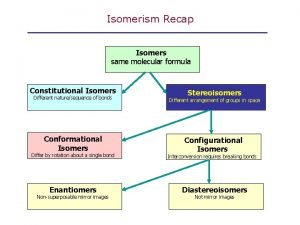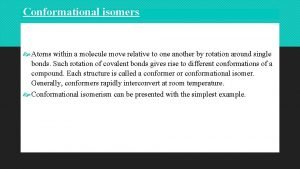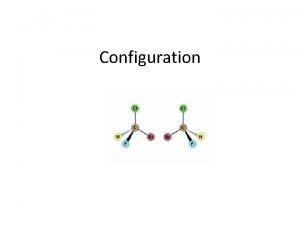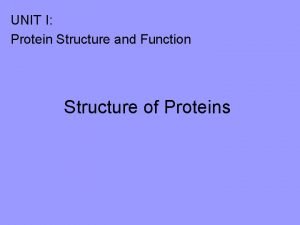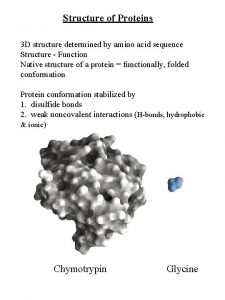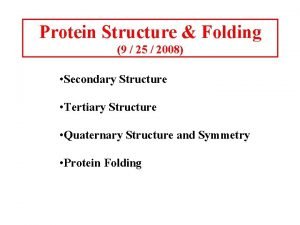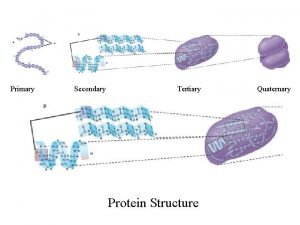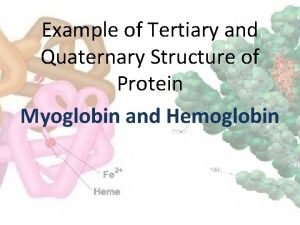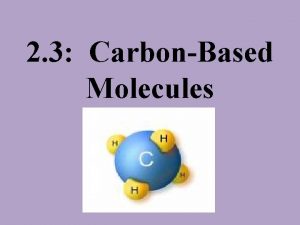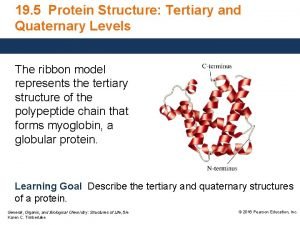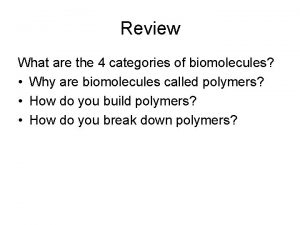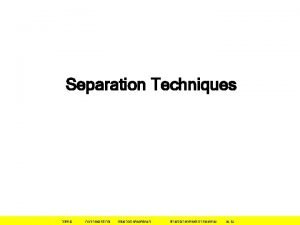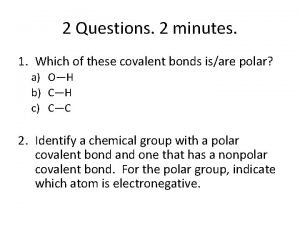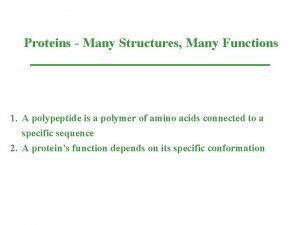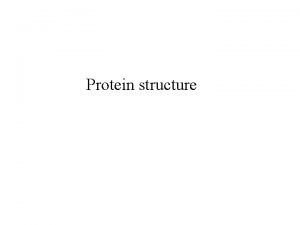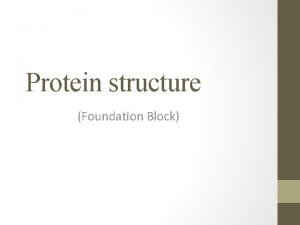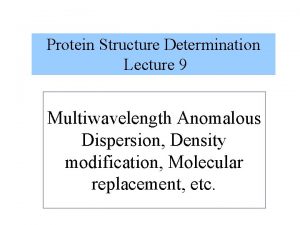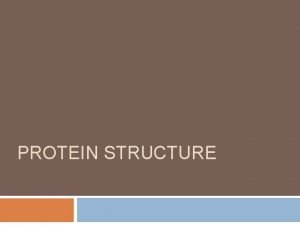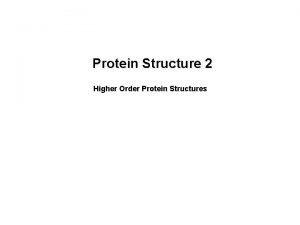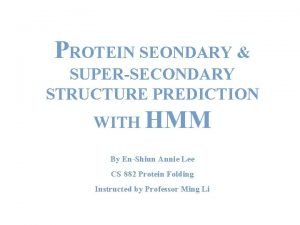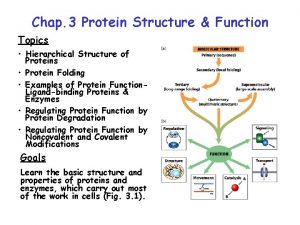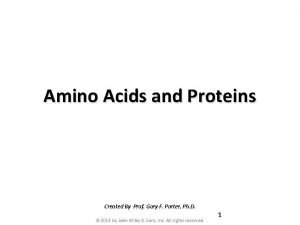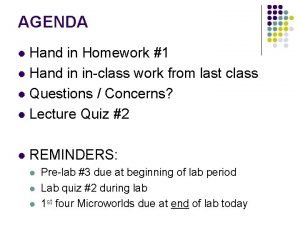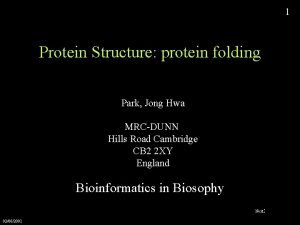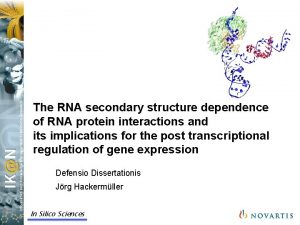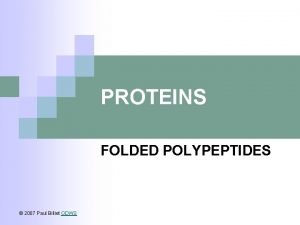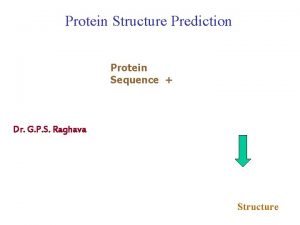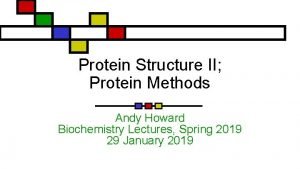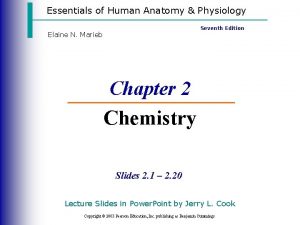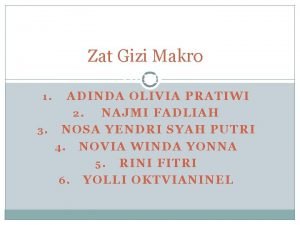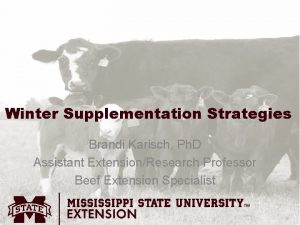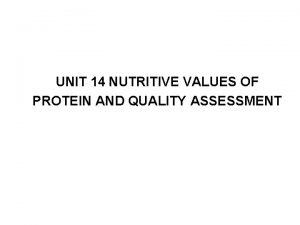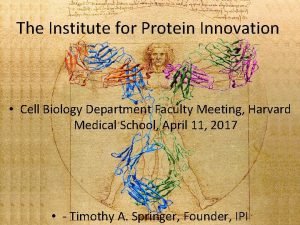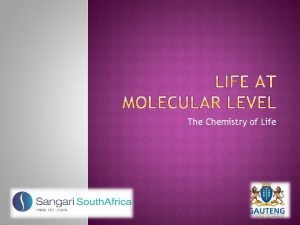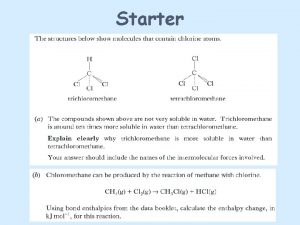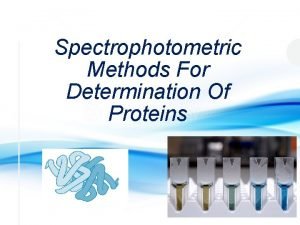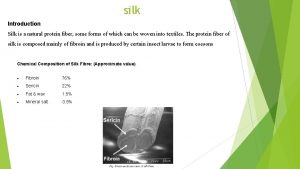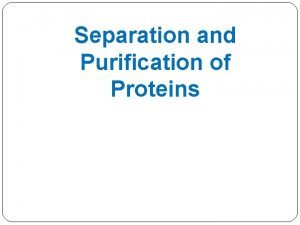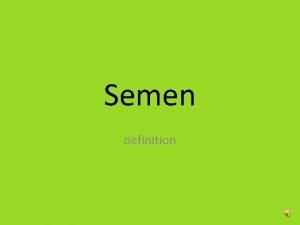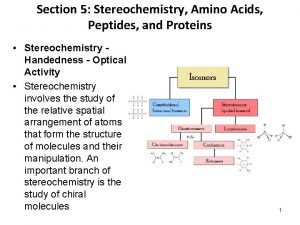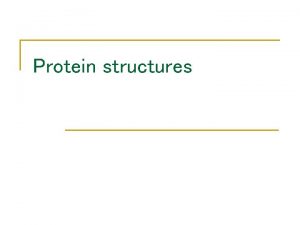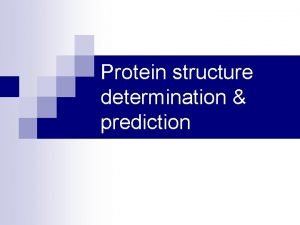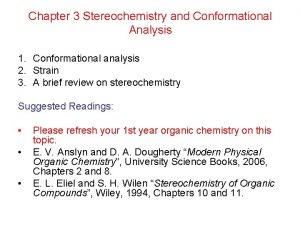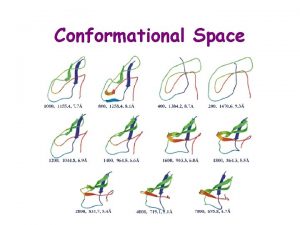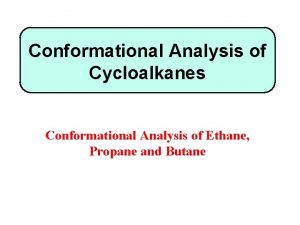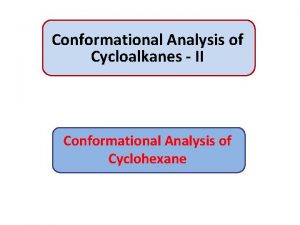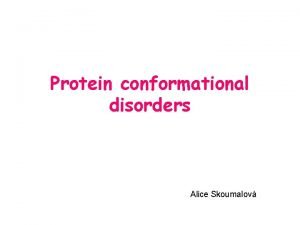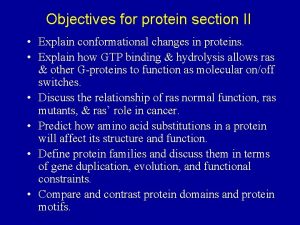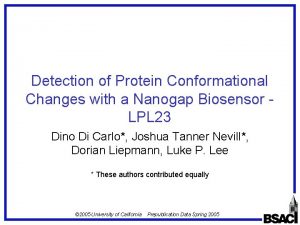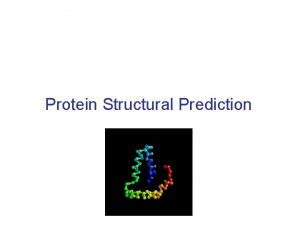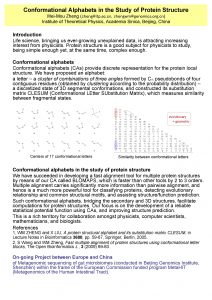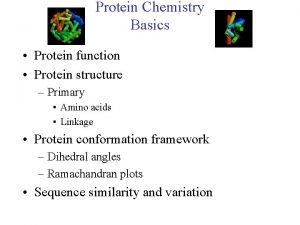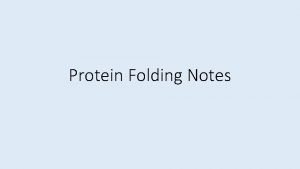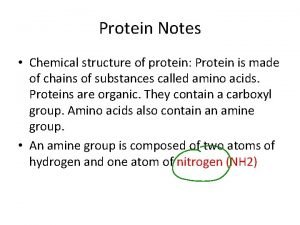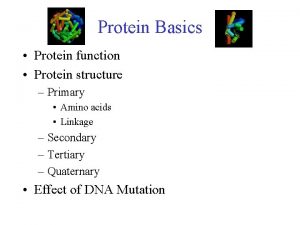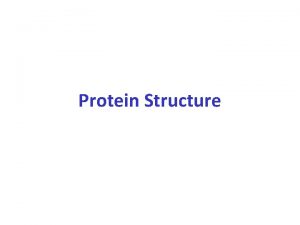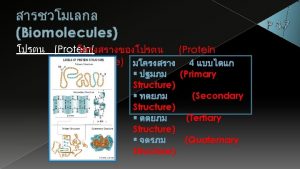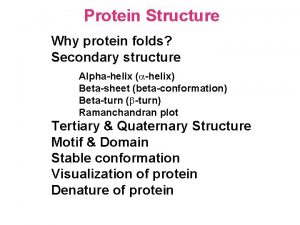CONFORMATIONAL CHANGES IN PROTEIN STRUCTURE Structural changes arising


























































- Slides: 58

CONFORMATIONAL CHANGES IN PROTEIN STRUCTURE • Structural changes arising from changes in state of ligation • Hinge motions in proteins • Mechanisms of conformation changes (Haemoglobin, Serpins, muscle contraction) • Higher level structural changes (Gro. ELS)

Main chain conformation The main chain conformation is the space curve that the backbone traces out Under physiological conditions of solvent and temperature, all the molecules with the same amino acid sequence acquire the same native state Protein architecture is the study of how folding patterns may be classified, internal interactions and determination of protein’s conformation by the amino acid sequence The bond lengths and angles are fixed: the degrees of freedom of the chain involves four successive angles, in which the three are fixed and only the fourth can rotate around the bond linking the second and theird atoms

The peptide bond constrains the polypeptide The peptide backbone conformation can be described In terms of two dihedral angles, Phi (F) and Psi (Y). Phi is the dihedral angle for the N-C bond (hetero) Psi is the dihedral angle for the C -C bond (same)

Dihedral angle Berg Fig. 3. 27 9/14/05

Trans and cis peptide bonds The trans configuration is adopted for almost all peptide bonds.

The peptide bond constrains the polypeptide So in addition to the peptide bond, sterics inhibit peptide backbone motion. This comes from peptide backbone and from R group. Shown here, F = 0, Y=0 combination is forbidden. A few amino acids have unique sterics-

The peptide bond constrains the polypeptide Ramachandran plot for L-Ala. "Allowed regions" of conformational space are in blue. Two main allowed regions: = -57º; = -47º ( R region) = -125º; = +125º ( region) The mirror image of R is L and is only permitted for Gly. R

Glycine is highly flexible A Ramachandran Plot for Polyglycine “Conformational Space" constrained by peptide bond only Fully allowed At limits of allowability Pro

Conformational space has defined regions Ramachandran plot for L-Ala. Region for righthanded a-helix. "alpha"

The -helix Ball-and. Stick models

The -helix • Most common type of 2˚ structural element (about 25% of the amino acids in proteins are in this structure) • Right-handed helix • R-groups project outward, and provide the main constraints on helical structure • Stability is greatly enhanced by internal van der Waals contacts • H-bonds are in-line, optimum distance

The a-helix

The -helix "wheel" depiction down helix axis Helix dipole results from orientation of CO - NH hydrogen bonds. What does this imply for the preferred placement of + and - amino acids along a helix? 3 7 4 6 2 8 9 5 1

Conformational space has defined regions Ramachandran plot for L-Ala. Region for -strands beta

The -strand • Highly extended form of polypeptide chain. • 3. 5 Å between adjacent residues (1. 5 Å for a-helix!) • Adjacent side chains point in opposite directions. • A beta strand usually is associated with other beta strands….

The -sheet Antiparallel Note: • H-bonds • R-groups orientation, distance. • Pleated character • Ave. strand length is about 6 aa’s 0. 7 nm

The -sheet Parallel Note: • H-bonds not at optimal angle. • R-group orientations, distances • Pleated character • Avg. Strand length ~ 6 aa. 0. 65 nm

The -turn • Connects other 2˚ structure elements, causes the backbone to reverse direction. • a 4 amino acid loop, reversing direction 180 o • An H-bond between C=O of aa 1 and NH of aa 4 is found • aa 3 is often Gly, which is small, flexible • aa 2 may be Pro, whose cis-conformation turns tightly • Usually occurs at surfaces, connecting antiparallel b-strands • There are different types (I, III) depending on conformation.

Fibrous proteins In general, fibrous proteins are - built up from a single element of secondary structure - insoluble in water (lots of hydrophobic residues) - involved in structural roles within the cell

Sidechain conformation are described by angles of internal rotation ( 1 and 5) Different sidechains have different degrees of freedom Arg 5 Gly and Ala 0 Rotamers = conformations of any sidechains corresponding to different combinations of values C 60º (g-) 180º (t) 60º (g+)

Rotamer libraries = statistical analysis of patterns of conformational angles in well-determined protein structures (collections of preferred sidechain conformations) Local backbone conformations as well as secondary protein structures limit the possible range of sidechain internal rotations due to potential steric collisions The small number of possible internal conformations for sidechains make rotamer libraries of sidechains ideal for modelling

Structural changes from changes in ligation conformation change Carrier conformation change mediated solute transport • Carrier proteins cycle between conformations in which a solute binding site is accessible on one side of the membrane or the other. • There may be an intermediate conformation in which a bound substrate is inaccessible to either aqueous phase. With carrier proteins, there is never an open channel all the way through the membrane.

Proteins as carrier conformation change Carrier conformation change mediated solute transport Carrier proteins cycle between conformations in which a solute binding site is accessible on one side of the membrane or the other. There may be an intermediate conformation in which a bound substrate is inaccessible to either aqueous phase. With carrier proteins, there is never an open channel all the way through the membrane.

Conformational changes in proteins In some proteins, the binding with ligands or other proteins can lead to dramatic conformational changes (Haemoglobin + Oxigen) In some other cases changes in the structure are not significant or affect the protein only locally (Myoglobin + Oxigen) Allosteric transitions involve long-range integrated conformational changes (haemoglobin) Some other proteins act as pump or motors through changes in conformation (Myosin of muscle, ATPase, Gro. ELS)

Myoglobin Heme 3

Myoglobin binds oxygen in muscle cells. The heme prosthetic group is sequestered in a deep heme binding pocket. Heme Fe 2+ X Fe 3+

Heme function Oxygen is not very soluble in water. To transport oxygen in our blood we use a protein, hemoglobin. None of the amino acids efficiently binds oxygen. Hemoglobin uses iron (Fe 2+) to coordinate oxygen. Free iron generates oxygen radicals that are harmful. Hemoglobin sequesters iron in a heme prosthetic group. Fe 2+ in a heme is less reactive. The nitrogens prevent conversion from the ferrous state (Fe 2+) to ferric state (Fe 3+) In free heme molecules, binding of oxygen converts Fe 2+ to Fe 3+. Sequestering the heme in hemoglobin prevents this conversion. Binding of oxygen by hemoglobin changes the properties of heme. The heme changes color, this is why veins are blue and blood exposed to the air is red.

Myoglobin binds oxygen in muscle cells Hemoglobin transports oxygen in the blood

Hemoglobin subunits are structurally similar to myoglobin

Specificitiy of ligand binding Heme binds carbon monoxide (CO) 20, 000 times better than O 2 Myoglobin binds CO 200 times better than O 2 The protein portion of myoglobin sterically interferes with CO binding to the heme. A histidine (the distal His) interacts with the ligand (CO or O 2).

Oxygen binds to heme with the O 2 axis at an angle. This binding conformation is accommodated by myoglobin.

Carbon monoxide normally binds to heme with the CO axis perpendicular to the plane of the porphyrin ring. This binding conformation is sterically hindered by the distal histidine in myoglobin.

Binding of ligands to the heme of myoglobin Even though the difference between deoxy and oxy forms of myoglobine are not huge, the oxigen-binding site is blocked and the molecule must open up during the process of capture and oxygen release Distal His Proximal His

Hb oxygen transport Oxygen transport • Haemoglobin - oxygen transporter Molecular mechanism of oxygen-binding Role of DPG Emphysema Foetal vs Adult haemoglobin His F 8

Max Perutz (1914 -2002)

Molecular mechanism of Hb co-operativity Overview In the low-affinity, tense (T) state, deoxy-Hb (no bound oxygen) contains numerous intersubunit interactions. DPG is bound on one face of the tetramer, at the subunit interface Upon oxygen binding, the architecture of the Hb tetramer transmits conformational changes from the oxygen binding site to the intersubunit interfaces (and vice versa). The DPG binding site is altered and DPG dissociates from the Hb molecule. As oxygen binds, the intersubunit contacts loosen; each subunit becomes more like myoglobin and adopts Mb-like affinity for oxygen

Molecular mechanism of Hb co-operativity Details The tense state is stabilised by intersubunit interactions, in particular a network of electrostatic interactions between amino acids. 2 1

Molecular mechanism of Hb co-operativity The tense state is also stabilised by the binding of the negatively charged co-factor, DPG

Molecular mechanism of Hb co-operativity DPG plays a major role in T-state stabilisation; in the absence of DPG, Hb switches to the R-state (high affinity) and is not capable of displaying co-operativity. Hb without DPG Y Hb

Molecular mechanism of Hb co-operativity Oxygen binding to heme causes the Fe atom to move about 0. 4 Å (0. 04 nm) into the plane of the heme This displaces the proximal histidine (His F 8) and helix F to which it is attached.

Molecular mechanism of Hb co-operativity As well as displacing helix F, the flattening of the porphyrin ring upon oxygen binding causes displacement of a Val residue in the turn between helix F and helix G. His F 8

Molecular mechanism of Hb co-operativity The F helix is also in close proximity to the inter-subunit interfaces. Thus, oxygen binding in one subunit is communicated to the other subunits. Ultimately the binding of oxygen produces a large conformational change.

Molecular mechanism of Hb co-operativity The global conformational change is quite large: one dimer rotates relative to the other by 15° and shifts by 0. 8 Å. T-state R-state Top View

Molecular mechanism of Hb co-operativity T-state

Molecular mechanism of Hb co-operativity R-state In the R-state, there is a looser association of subunits. Once converted to the R-state, the barrier to oxygen binding is removed and oxygen affinity rises. The last oxygen molecule to binds 20 -300 times tighter than the first.

Molecular mechanism of Hb co-operativity The conformational changes, initiated by 2 movement of helix F, also rupture the 1 network of electrostatic interactions between subunits (across 2 and interfaces). This helps to relax the 1 contacts between subunits.

Molecular mechanism of Hb cooperativity Switch: Stabilisation of the R-state

Molecular mechanism of Hb cooperativity High O 2 Effectively, the binding energy of the first oxygen molecule is partly “consumed” in order to relax the Hb structure (loosen the intersubunit contacts); thus the initial oxygen affinity is low. Once converted to the R-state, the barrier to oxygen binding is removed, thereby increasing oxygen affinity. T R Low O 2

Effect of CO 2 and O 2 antagonise each other’s binding The ability of Hb to sense and respond appropriately to differing oxygen levels is a well-balanced mechanism for self regulation. Hb is also sensitive to p. H (H+ ion concentrations) and to carbon dioxide (CO 2) levels. In very active cells, such as contracting muscle, CO 2 and H+ concentrations increase. CO 2 can bind to Hb and in doing so stabilises the low-affinity T-state. CO 2 can react with the amino termini of polypeptides to form a negatively charged carbamate. This modification at the N-terminal of the -subunits generates an electrostatic interaction with Arg 141 from the nearest -subunit which stabilises the Tstate, promoting deoxygenation.

The Bohr effect The Bohr Effect H+ can also bind to Hb to stabilise the low-affinity T-state. At low p. H (high [H+]), His 146 from the -subunits becomes protonated (positively charged) and can make a salt-bridge to Asp 94 from the same chain. This helps to stabilise the interaction between the COOH of His 146 and Lys 20 from the nearby chain In active cells therefore, Hb even more readily gives up its bound oxygen; thus oxygen is automatically targeted to the cells where it is most needed. This is known as the Bohr effect. Christian Bohr’s Son

The Bohr Effect The Bohr effect increases the transport efficiency of Hb. 66% Hb also functions to assist the removal of CO 2 from the bloodstream. In the lungs the Bohr effect works in reverse to facilitate the dissociation of CO 2. Since CO 2 and O 2 bind antagonistically, the presence of high concentrations of O 2 in the lungs, induces release of bound CO 2 from Hb molecules arriving there from the tissues.

4. 7 The role of 2, 3 -diphosphoglycerate (DPG) The body can regulate DPG levels and the affinity of Hb for this co-factor to control the oxygen affinity of Hb in response to particular circumstances. Example 1 Emphysema People suffering from emphysema (destructive lung disease due to overactive neutrophil elastase) have a lower partial pressure of oxygen in their lungs. Their bodies compensate by increasing DPG levels. This increases the stability of the T-state and lowers the affinity for oxygen at the very low oxygen partial pressures which are found in the tissues of the body

The role of DPG The body can regulate DPG levels and the affinity of Hb for this co-factor to control the oxygen affinity of Hb in response to particular circumstances. This allows more effective oxygen transport ( Ycomp > Y 0) because of increased dissociation in the tissues (at very low partial pressures).

The role of DPG Serious mountain climbers need to spend time acclimatising before ascending too high. This gives the body time to increase DPG levels to allow the climber to cope better with the lower oxygen pressures that occur at high altitudes.

The role of DPG Smoking makes emphysema worse if you have a mutant version of 1 -antitrypsin (=anti -elastase). The smoke oxidises Met 358 in the inhibitor molecule, a residue essential for its binding to elastase. 1 -antitrypsin

The role of DPG Example 2 - Foetal haemoglobin The foetal oxygen transport problem is quite different to that of children or adults. Foetal haemoglobin must transport oxygen from the mother’s placenta to itself; it has to compete for oxygen with the maternal haemoglobin. The foetus competes effectively by making a Hb molecule (Hb F) with higher oxygen affinity, especially at lower partial pressures, than adult Hb (Hb A).

The role of DPG Hb F is made from 2 and 2 chains are derived from a gene that is only active during the foetal stage of development. The gene for the chain is only switched on (and the gene switched off) after birth.

The role of DPG and chains have a number of amino acid sequence differences. Most notably, His 143 in , at the DPG binding site, is replaced by Ser in the chain. The loss of a positively charged residue reduces the affinity of Hb F for DPG, thus destabilising the Tstate and favouring the R-state. The result is that oxygen affinity goes up (since the R-state is a higher affinity state).
 Behavioural segmentation example
Behavioural segmentation example Chapter 5 consumer markets and buyer behavior
Chapter 5 consumer markets and buyer behavior Changes in an individual's behavior arising from experience
Changes in an individual's behavior arising from experience Analyzing consumer markets
Analyzing consumer markets Changes in an individual's behavior arising from experience
Changes in an individual's behavior arising from experience Reinforcement schedule types
Reinforcement schedule types Stereoisomer vs constitutional isomer
Stereoisomer vs constitutional isomer Conformational isomerism
Conformational isomerism Interconvertable
Interconvertable Carrier vs channel proteins
Carrier vs channel proteins Protein-protein docking
Protein-protein docking Functions and importance of proteins
Functions and importance of proteins Elizabeth mulroney
Elizabeth mulroney What is chemical change
What is chemical change Alpha helix and beta sheet
Alpha helix and beta sheet Fibroin secondary structure
Fibroin secondary structure Super secondary structure of protein
Super secondary structure of protein Primary secondary tertiary
Primary secondary tertiary Secondary structure of protein bond
Secondary structure of protein bond Is myoglobin tertiary or quaternary
Is myoglobin tertiary or quaternary Protein monomer
Protein monomer Primary secondary and tertiary protein structure
Primary secondary and tertiary protein structure Adenine thymine cytosine and guanine
Adenine thymine cytosine and guanine Protein primary structure
Protein primary structure Quaternary structure of protein
Quaternary structure of protein Protein tertiary structure bonds
Protein tertiary structure bonds Protein structure
Protein structure Hierarchy of protein structure
Hierarchy of protein structure Protein structure determination
Protein structure determination 64 amino acids
64 amino acids Super secondary structure of protein
Super secondary structure of protein Super secondary structure of protein
Super secondary structure of protein Hierarchy of protein structure
Hierarchy of protein structure Type of enzyme inhibition
Type of enzyme inhibition Leucine polar or nonpolar
Leucine polar or nonpolar Protein unfolding
Protein unfolding Nnuuu
Nnuuu Primary secondary and tertiary structure of protein
Primary secondary and tertiary structure of protein Protein structure
Protein structure Protein structure
Protein structure Protein structure
Protein structure Protein sparer
Protein sparer Brandi needs her protein
Brandi needs her protein Net protein utilization
Net protein utilization Institute of protein innovation
Institute of protein innovation Protein denaturation definition
Protein denaturation definition Deficiency disease of protein
Deficiency disease of protein Jalinan endoplasma licin banyak di
Jalinan endoplasma licin banyak di Totipotent cell
Totipotent cell Protein hydrolysis
Protein hydrolysis Principle of bradford assay
Principle of bradford assay Silk is a natural protein fiber some forms of which can be
Silk is a natural protein fiber some forms of which can be Protein fractionation by charge
Protein fractionation by charge Seamen definition sperm
Seamen definition sperm What is protien
What is protien Perly protein
Perly protein Section 12 3 rna and protein synthesis answers
Section 12 3 rna and protein synthesis answers Messenger rna codons
Messenger rna codons Cell restaurant analogy
Cell restaurant analogy






